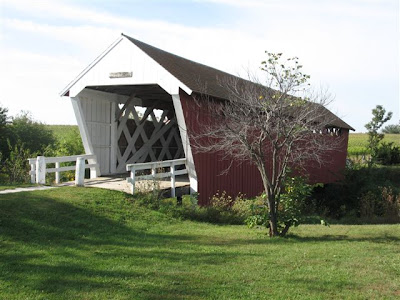The story is set in and around the small town of Winterset in Iowa and is a narrative about love and choices and consequence. I really like the film but up until now had never read the book.
We visited the area for a day from Indianola, IA.
There were originally twenty covered bridges but only 5 remain (plus one replica). The bridges were covered by order of the county board of supervisors to help preserve the flooring timbers which were more expensive to replace than the timber covering the sides and the roof. Most of the construction work was done by farmers to pay their poll taxes. The bridges were usually named for the nearest resident.

The Imes Bridge is the oldest remaining covered bridge built in 1870. It was first located over Middle River near Patterson but has been moved a number of times ending up east of St. Charles in 1997.

The Holliwell bridge was built in 1880 by Benton Jones and is located over the Middle River just southeast of Winterset. It is the longest of bridges measuring 122 feet. The interior is a good example of the intricacy of the timber work that is a feature of all the bridges.

The Cutler- Donohue bridge was moved from its original position over the North River near Bevington to Winterset City Park in 1970.

Winterset has another claim to fame.
It was the birthplace of John Wayne and his small four roomed house is open for tours and has a large collection of the actor's memorabilia.
We liked Winterset and its surrounds. The county has a population of around 14,500 and is set in a rolling terrain with wooded hills, small streams and rivers as well as corn and bean fields. The town lives off the film's popularity but the day we were there it was quiet and sleepy. The courthouse which sits in the middle of town is quite impressive. It was constructed in 1876 from the limestone of the area with the dome rising 122 feet above the central square.
The Northside Cafe, in existence since 1876, is the restaurant in the film where Robert Kincaid stops for coffee and offers Lucy Redfield a stool. The cafe is popular with film buffs and there were few in there taking photos. You can still take a seat where Clint Eastwood sat - it's the fourth stool from the front of the restaurant.
Unfortunately the cafe lives on that reputation rather than that of its food but it was fun to be there.
We explored the small town, had good coffee and found a second hand bookstore overflowing with bargains. I picked up a copy of the novel in pristine condition. The co-driver also found an apparently famous store in the quilting world, Fons and Porters.
The Hogback bridge is in its original position in a lovely valley just northwest of the town. Hogback gets its name from the limestone ridge which forms the west end of the valley. By this time the dust of the limestone back roads had covered our red car in a thick white layer. This turned out to be the norm and most cars we saw parked in the main street or on the country roads were similarly affected. Sorry Mr. Enterprise but we really did have to go off the tarmac to see everything.
The Roseman bridge has been in the same location since 1883. This is the best known bridge and played a prominent role in both film and book. The interior is covered in graffiti from romantics from all over the world. This is the bridge Robert Kincaid is looking for when he stops at Francesca Johnson's for directions. It is also where Francesca leaves her note inviting him to dinner. Also known as the "haunted" bridge, Roseman is where two sheriff's posses trapped a county jail escapee in 1892. Uttering a wild cry, it is said the man rose up straight through the roof of the bridge and disappeared. He was never found, and it was decided that anyone capable of such a feat must be innocent.
This was a most enjoyable day with the warm late summer weather making things even better.
I am glad we took the time to visit the area, basically on a whim, and were so well rewarded.
I have now read the book and was quite amazed how closely the film script adapted by Richard LaGravenese from the novel follows the original story. I guess when you are on a good thing.....
And as pure coincidence, the movie was running on our "Movie Greats" channel when we returned to Australia. Of course we watched it again.
And she still didn't get out of the truck!!!!!
























No comments:
Post a Comment